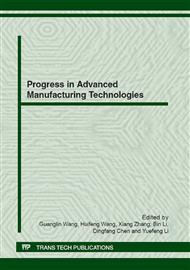[1]
M.J. Chen, G.B. Xiao, J.X. Chen, C.Y. Wu, Research on the influence of machining introduced sub-surface defects and residue stress upon the mechanical properties of single crystal copper, Science China Technological Sciences, 53 (12): 3161 (2010).
DOI: 10.1007/s11431-010-4122-1
Google Scholar
[2]
J.X. Chen, Y.C. Liang, Q.S. Bai, Y.L. Tang, M.J. Chen, Reseaching Nanometric Cutting of Copper Based On Molecular Dynamics, Journal of Computational and Theoretical Nanoscience, 5: 1485 (2008).
DOI: 10.1166/jctn.2008.806
Google Scholar
[3]
S. Shimada, H. Tanaka, M. Higuchi, T. Yamaguchi, S. Honda and K. Obata. Thermo-chemical wear mechanism of diamond tool in machining of ferrous metals. CIRP Annals - Manufacturing Technology. 53, 57 (2004).
DOI: 10.1016/s0007-8506(07)60644-1
Google Scholar
[4]
M. Uemura. An analysis of the catalysis of Fe, Ni or Co on the wear of diamonds. Tribology International. 37, 887 (2004).
DOI: 10.1016/j.triboint.2004.07.004
Google Scholar
[5]
Y. G. Gogotsi, A. Kailer, K. G. Nickel. Materials: Transformation of diamond to graphite. Nature. 401, 663 (1999).
DOI: 10.1038/44323
Google Scholar
[6]
H. Chacham, Leonard Kleinman. Instabilities in Diamond under High Shear Stress. Physical Review Letters 85, 4904 (2000).
DOI: 10.1103/physrevlett.85.4904
Google Scholar
[7]
V.L. Kuznetsov and Yu.V. Butenko. Nanodiamond Graphitization and Properties of Onion-Like Carbon. 192, 199 (2005).
DOI: 10.1007/1-4020-3322-2_15
Google Scholar
[8]
F. Y. Xie, W. G. Xie, L. Gong, W. H. Zhang, S. H. Chen, Q. Z. Zhang and J. Chen, Surface characterization on graphitization of nanodiamond powder annealed in nitrogen ambient. Surface and Interface Analysis. 42, 1514 (2010).
DOI: 10.1002/sia.3350
Google Scholar
[9]
G. Jungnickel, C.D. Latham, M.I. Heggie, Th. Frauenheim. On the graphitization of diamond surfaces: the importance of twins. Diamond and Related Materials. 5, 102 (1996).
DOI: 10.1016/0925-9635(96)80012-4
Google Scholar
[10]
G. Kern and J. Hafner . Ab initio molecular-dynamics studies of the graphitization of flat and stepped diamond (111) surfaces. Phys. Rev. B. 58, 13167 (1998).
DOI: 10.1103/physrevb.58.13167
Google Scholar
[11]
A.A. Gippius, R.A. Khmelnitsky, V.A. Dravin, A.V. Khomich. Defect-inducedgraphitisation in diamond implanted with light ions. Physica B: Condensed Matter. 308–310, 573 (2001).
DOI: 10.1016/s0921-4526(01)00738-4
Google Scholar
[12]
L.S. Li, Xiang Zhao. Dangling bond-induced graphitization process on the (111) surface of diamond nanoparticles. J. Chem. Phys. 134, 044711 (2011).
DOI: 10.1063/1.3528726
Google Scholar
[13]
T. Evans, D. H. Sauter. Etching of diamond surfaces with gases. 6, 429 (1961).
Google Scholar
[14]
M. Seal. The Effect of Surface Orientation on the Graphitization of Diamond. Physica status solidi (b). 3, 658 (1963).
DOI: 10.1002/pssb.19630030408
Google Scholar
[15]
G. Davies, T. Evans. Graphitization of Diamond at Zero Pressure and at a High Pressure. Proceedings of the Royal Society of London. A. 328, 413 (1972).
Google Scholar
[16]
Nath. N. S. N. Proceedings of the Indian National Science Academy . A2, 143-152 (1935).
Google Scholar
[17]
T. Evans, P. F. James. A Study of the Transformation of Diamond to Graphite. Proceedings of the Royal Society. 277, 260 (1964).
Google Scholar
[18]
L. Vladimir. Kuznetsov, Yuriy V. Butenko. Diamond Phase Transitions at Nanoscale. (2006).
Google Scholar
[19]
V. L. Kuznetsov, a) I. L. Zilberberg, Yu. V. Butenko, A. L. Chuvilin. Theoretical study of the formation of closed curved graphite-like structures during annealing of diamond surface. Journal of Applied Physics. 86, 863 (1999).
DOI: 10.1063/1.370816
Google Scholar
[20]
R. H. Telling, C. J. Pickard, M. C. Payne, J. E. Field. Theoretical Strength and Cleavage of Diamond. Physical Review Letters. 84, 5160–5163 (2000).
DOI: 10.1103/physrevlett.84.5160
Google Scholar


